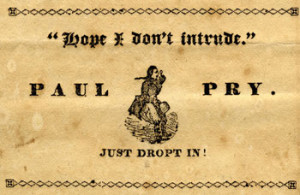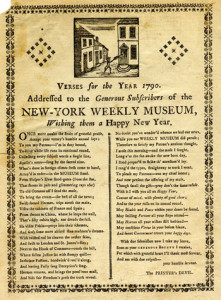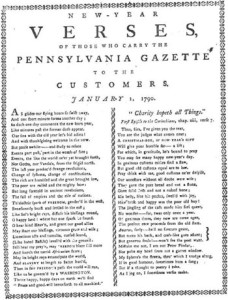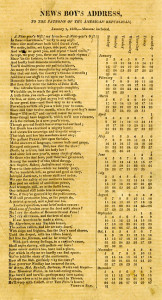We Won’t Leave Until We Get Some
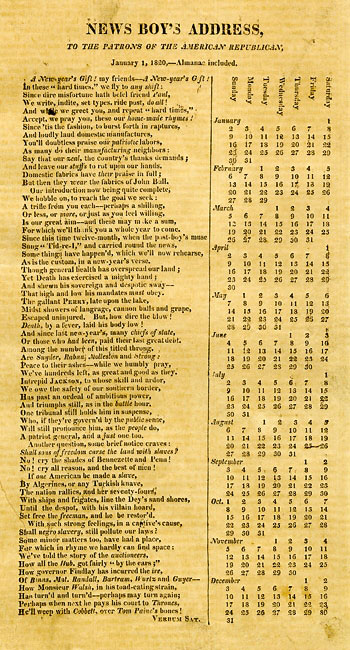
Reading the newsboy’s New Year’s address
When I was fourteen, I began my first newspaper route. It was a grim and unrewarding job. My chief memories are of waking before dawn and trudging the London streets under steel gray skies, forcing oversized papers into undersized mail slots whose spring-loaded maws were designed to shred every object, being pelted with snowballs by delivery boys from a competitor’s news agency, and—on one memorable occasion—being chased by a fierce and bristling dog several blocks down the main road. The detour I was forced to contrive to avoid the house with the dog added an additional mile to my route and took me still deeper into the snowball throwers’ territory. It was, in short, a miserable chore.
The one thing that made it at all bearable was the day in late December when I knocked on the door of each house and received my “Christmas box,” a small (sometimes not-so-small) sum of money traditionally given to newspaper boys, milkmen, and others in the delivery business and which I spent on such Tom Sawyeresque accoutrements as penknives and candy. Not everyone answered the door, of course. But those who did not could expect the wrong paper to appear in their mail slot or to find the right paper pushed through their slot with such vigor as to turn the outer pages into expensive confetti. Few dared to risk my ire, and so in response to my mumbled incantation of “Christmas box,” wooly hat clutched firmly in hand, I took in a substantial sum. All in all, the day after Christmas was a pretty good day.
I could not have known it as a teenager—and would likely not have cared—but in soliciting money from my newspaper customers on the cusp of the new year, I was participating in a ritual that was several centuries old and rooted deeply in American, as well as in English, history. Beginning in the early eighteenth century and enduring clear through the nineteenth, newspaper boys—and the occasional girl—hit up their customers in much the same way that I had done. The resemblances in our experiences, once I discovered them, were uncanny. Currency and inflation issues aside, my American antecedents—especially those of the antebellum period—differed from me in two important ways. Firstly, they visited their customers not on the day after Christmas but rather on New Year’s Day, a point to which I will return at the end of this column. Secondly, and perhaps more importantly, in making their plea for money, the historical carriers did not mumble their requests but presented them more decorously in the form of printed broadside poems. These poems were written sometimes by the newspaper editor or one of his friends and sometimes by the carrier himself, but they were always presented from the carrier’s perspective and in the carrier’s voice. They are remarkable documents.
The typical newspaper carrier’s New Year’s address—as they were known—began with a salutation to the customer; mythologized the newsboy as the embodiment of Hermes or Mercury, messenger to the Gods; summarized the news of the year in brisk and vivid couplets; and concluded with a plea for money. Appearing first in the 1720s in sporadic numbers, the vogue for addresses caught on in the 1760s, and by the end of the eighteenth century almost every newspaper issued one. Writing from Portland, Maine, in January 1823, Henry Wadsworth Longfellow told a college classmate in Norridgewock, Maine, “We have Carriers’ and News-boys’ good wishes in abundance and I suppose they are plenty with you.”
They were plentiful indeed. A recent bibliography published by the American Antiquarian Society (AAS), covering the first century of the addresses, lists almost one thousand examples. Several thousand more exist for the mid- to late nineteenth century, when newspaper production and consumption exploded. Yet despite the AAS’s bibliography and the fact that almost all of the addresses are themselves available online, the genre has received almost no sustained scrutiny. The addresses are, in fact, perhaps the most extensive literary genre of the colonial and early national period about which practically nothing has been written. This is a shame because they are fascinating documents from which we can learn a great deal about artisanal culture, the commercialization of Christmas, changes within the newspaper trade, the development of the middle class, and changing perceptions of youth, labor, and leisure.
I recently had the chance to read about seven hundred of the carriers’ addresses while working on my first book, The Business of Letters (Stanford, Calif., 2008). My goal in that project was to excavate and interpret the various economic systems through which authors disseminated their written and printed words. My argument, in a nutshell, was that rather than being dominated and defined by a single, market-based economy, texts were disseminated through a number of different economies—charity, patronage, gift-exchange, credit network, competitive writing, and so on—each of which had its own distinct rules and regulations, modes and moralities, even currencies. Unlike almost all of the other literary materials I used, the carriers’ addresses made the terms on which they sought money, and the reasons for seeking it, quite explicit. Hardly any of the addresses failed to conclude without a crafty plea for payment, and the fact that there were so many examples written over so long a period simply made them all the more useful. In the final editorial cuts for the book, I chose to excise my discussion of the addresses, a move I always regretted because in addition to being literarily fascinating they were also economically perplexing.
The challenge of the addresses lay in identifying precisely the sort of economic arrangement of which they were a part. Was it a form of extortion, a kind of gift exchange, an instance of charity, a variety of purchase, or some other part of the economic repertoire? I could not say, nor did my own experiences as a newspaper carrier offer much insight. The ritual in which I participated as a teen, just like the one engaged in by those in colonial and early national America, was one that all my customers—including those who declined to participate—seemed to understand but that no one possessed the ability or inclination to verbalize. What kind of economic transaction could this be that was so compelling yet so fraught with reticence and the potential for embarrassment?
When I first began reading the addresses, I gave this a great deal of thought and came to see the bestowal of addresses and Christmas boxes as an example of tipping and the gratuity economy. To an extent I still do. After all, the tip itself is a highly fraught transaction characterized by reticence, awkwardness, and taxonomic indeterminacy. According to economic sociologist Viviana Zelizer, tips are situated “at the boundary of other critically different transfers, not quite a payment, not quite a bribe, not quite charity, but not quite a gift either.” Not quite any of these economies—indeed always a supplement to other economies rather than an independent one itself—the tip borrows elements from each, presupposing the social inequality of charity but the professed warmth of the gift, the obligatory force of a payment and the coercive freight of the bribe but melded to the discretionary pretense of a present. Tips are supplemental, supernumerary, gratuitous; indeed, they reflect a certain impossibility. It is not possible to define a tip on its own terms, that is to say, only in terms of other economies. Although solicited in the context of a determinate commercial transaction, the tip, in essence, was redundant, oxymoronic even, seeking something for nothing.
The monies associated with carriers’ addresses shared this same protean quality. They were not quite a payment for delivery, since this was included in the cost of the paper; they were not quite charity, since something was given as well as received; and they were not extortion, because of the ongoing nature of the relationship between the carrier and the customer, both of whom knew one another; yet they could not be considered gifts either, since they were not exchanged between equals but given to lower-class men by their social betters. The concept of the tip would seem to capture perfectly the nature of the carriers’ transaction in its ambiguity, its scripted, ritualized nature, its awkwardness, and its potential for social transgression, and I was at first quite happy to call the money the carriers’ received tips. That seemed easy enough.
The only problem is that even though the word tip was used in its modern sense as early as 1733, at precisely the same time that the carriers’ addresses were starting to appear, tip does not appear in even one of the seven hundred or so addresses at which I looked. The money for which the carriers asked was, rather, described as a “boon,” a “bounty,” “a gift,” a “blessing,” “a present,” “a reward,” a form of “charity,” and much else. Indeed, every economy other than tipping was invoked. This surfeit of names led me to three provisional conclusions. Firstly, even as they bestowed addresses on their customers, the carriers were seeking to define the transactions in which they were engaged in terms of economies other than tipping. Secondly, such acts of economic designation obscured the precise—which is to say tipping—nature of the transactions in question. And lastly, this obfuscation was designed to give what was essentially a discretionary bestowal the force of an obligatory act. While tipping, in essence, demanded something for nothing, the economic labels invoked by the carriers’ addresses, as one of them explained, required “something for something.”
In staking their ethical and economic claims, the carriers had recourse to three models of discretionary-obligatory exchange, each one intimately associated with the season between Christmas and New Year’s Day. These practices were gift exchange, charity, and wassailing. Each offered something for something, although with varying degrees of reciprocity, to say nothing of amity.
In the eighteenth and early nineteenth century, New Year’s gift exchange was characterized by what anthropologist Marshall Sahlins has called “balanced reciprocity,” where a gift was responded to with a counter-gift of approximately equal value and within an expeditious time frame. The something one gave was a gift, and the something for which it was given was a gift in return. The value-equivalency of the gifts in question meant that Christmas gift exchange by definition took place between social equals.
Charity, by contrast—indeed by definition—flowed from those higher on the socio-economic ladder to those on its lower rungs. Often bestowed at Christmas time, it reflected a patrician world where the rich took care of the poor and the poor repaid them with gratitude and compliance. The something of charity, in other words, was repaid with the something of deference.
The last and most striking Christmas exchange ritual was wassailing. In a typical wassail, a group of poorer men would “invade” a home at Christmas time, sing songs or perhaps perform a brief play, and then demand money or food. The wassailers would refuse to leave until they had been recompensed, and if they were forcibly ejected they would undertake a campaign of sabotage and destruction that often lasted for months at a time. A wassail, in other words, inverted the hierarchical model of the charitable exchange by offering a coercive parody of gift exchange. The poor offered something the rich did not want to receive and then demanded in payment something they did not want to give. Wassailing, it’s worth mentioning, was also a part of my childhood years, as I joined gangs of boys in knocking on doors and “singing”—I use the word loosely—a carol that included the memorable line, “Now we all want some figgy pudding and we won’t leave until we get some.” Usually we received money, not the mysterious “figgy pudding,” and our audiences were glad to be rid of us.
All three of these Christmas practices pressed moral claims to reciprocity based on a tenuous exchange of something for something. But the somethings offered and received, and the terms on which they were exchanged, were defined by sharp class differences. Indeed, as Stephen Nissenbaum has compellingly argued, the “battle” over the meaning of Christmas in colonial and national America was fought across just this class-based economic terrain, with different constituencies laying claim to legitimacy for differing economic rituals. The carriers’ addresses were one of the major fronts where this protracted battle was waged.
Some carriers understood their efforts as engagements in a charitable economy through which they petitioned their wealthy patrons for sustenance in exchange for gratitude. A 1767 address concludes with a postscript that is almost painfully subservient.
Your Humble Slave
Does Prostrate lie,
And Humbly crave
Your Charity.
Its excessive tone notwithstanding, it is clear that many newspaper subscribers understood the money they gave out on New Year’s Day in just such a way: as largesse flowing from the wealthy and cultured to the modest and poor. Writing in his diary on New Year’s Day 1801, Philadelphia merchant Thomas Cope described the arrival of “the paper carrier for his boon & the watchman for his New Year’s gift. I love to make a cheerful heart. The awkward scrape of the leg, the smile of satisfaction & the thankee sir, thankee, are a rich regard for the trifle bestowed.” Note that while Cope was dispensing his money, which he called a boon, he felt that he was being recompensed by the deference and gratitude of the carrier. My younger self probably had something similar in mind in clutching my hat while seeking a Christmas box; it was a reflexive gesture for a child of working-class parents living in East London, even if I didn’t fully grasp the implications of the act. It suggested that I knew my place. Charitable money always comes with strings attached, and in this case, the strings kept the lower orders bowing and scraping like deferential marionettes.
Many apprentice printers, however, were schooled in an artisanal republicanism that vaunted the manual trades and rejected as inappropriate such fawning. Writing to poet Charles Prentiss in 1807 to commission an address for his apprentices, newspaper editor Benjamin Russell was happy to come “in forma pauperis“—that is, as a beggar—but he was quite emphatic that his carriers would not assume that role. In describing what Prentiss should include in the address, Russell insisted that it should “conclude with something like, and not beggary.” Russell’s description is immensely revealing, for if there is any rhetorical trait that best characterizes the addresses, it is precisely this tendency to approximate but not quite imitate beggary. In seeking to ask, yet not beg, for money, the authors of the carriers’ addresses typically moved from the language of charity to the language of gift exchange and even wassailing.
In eighteenth-century America, Christmas gift exchange was marked by a powerful reciprocity: one gave a present and received one back, or on the other hand, one received a present and then offered a counter-gift. In arguing that what they were due from their customers was nothing more than a gift well-earned and deserved, the carriers often described a number of gifts they had, or would, offer in return. Typically, the carriers pointed to the broadside poem itself, which they depicted as a gift to their patrons and for which they expected a gift of money in return. The same year the carrier for the Post Boy and Advertiser prostrated himself upon the floor, the carrier of the Connecticut Gazette claimed that the broadside he was dishing out was his gift, which he presented on terms of equality with his customers.
And tho, to most, tis much more pleasant
To take a Gift than make a present
Yet, as for mine, I’m free to make it,
As any soul can be to take it.
Give me a gift or not, the carrier seems to say, and see if I care, but take mine and you are at least in my debt.
The carrier for the 1791 Baltimore Gazette exploited the reciprocity inherent in this form of exchange still more when he concluded his address by writing,
Then Masters kind reward the Boy,
Whose labours brings the News
To oblige you is his chief employ
The GIFT you’ll not refuse.
His careful use of syntax helps to obscure whether the gift that will not be refused is the broadside the carrier is handing to his customer or the money the customer is giving him in return. More common still was the practice of making the traditional seasonal gift of a blessing. “I wish you a happy new year,” wrote one Massachusetts diarist in 1838, “is sounded from all most all lips.” Benedictions likewise run rampant through the carriers’ addresses, in which customers receive an endless barrage of May you alwayses, May you nevers, and May you oftens. A typical carriers’ blessing took the form of the hope that the customer would always be rich, never be poor, and often tip the newsboy.
While these nominal gift exchanges were the most typical strategy seen in carriers’ addresses, one can also find evidence of more coercive, and subversive, wassailing-type strategies, in which a gift, loosely construed, was inflicted upon the customer with the giver refusing to leave until they had received a counter-gift. A 1768 address captured the wassail spirit perfectly in concluding,
A small gratuity to your Swain
Who trudges of’t from Lane to Lane,
Thro’ thick and thin, with grateful Heart
He will receive, and then depart ————.
The carrier of the Pennsylvania Ledger of 1778 noted likewise that as he had
. . . nothing left but Paper —
A piece of Silver—how ‘twould make me caper
On wings of joy I’d disappear,
Nor trouble you again—till next NEW YEAR.
The implication in this jolly quatrain seems quite clear: if you want to make the carrier disappear, give him money; if you don’t he will (and it’s his word) “trouble” you. A similar threat is levied in the many addresses that include the phrase “hope I don’t intrude,” acknowledging tacitly that a wassail-like intrusion is precisely what is taking place (fig. 1). Intimations of the “figgy pudding” carol and its threat not to leave until fed are clear.
Sometimes the trouble threatened was more explicit still. Wrote a carrier for the New York Gazette in 1765,
My Memory’s bad—I confess I have mis’d
Sometimes, a good Customer—named in my List
But a Gift would my Memory greatly assist.
Translation: if you “forget” to give me a tip, I will “forget” to deliver your paper. Such threats approximate that of the modern newsboy to shred the paper or, to use the American example, to dump it in a puddle at the end of the driveway rather than tossing it, neatly and accurately, onto the doormat. (The plastic wrappers in which most newspapers are now delivered would seem to have obviated this threat, although no doubt the resourceful carrier could work around it.)
So far, we have seen that the New Year’s address poems transformed the instability and ambiguity of the tip into a more determinate form of reciprocal exchange, one in which something is given for the something demanded, albeit in different social and economic configurations. Offers of amity, docility, and compliance were extended along with an open hand ready to receive cash. The most interesting addresses, however, are those that embraced the very ambiguity of the tip transaction and left the nature of the substitute exchange uncertain. Two addresses of 1790—one from the New York Weekly Museum, the other from the Pennsylvania Gazette—capture precisely this economic indeterminacy; in each, the author of the address draws elements from two or more of the three Christmas rituals to claim his money, leaving it unclear on what grounds the transaction is being authorized.
The address for the New York Weekly Museum opens with a tone of great deference and describes the carrier as a “humble” “votary” “duty bound” for life to collect and dispense the news (fig. 2). Positioning himself in this manner, it would appear that the carrier will petition for charity.
Yet as the poem proceeds, the author invokes a labor theory of value, according to which inasmuch as he has collected the news and, indeed, “rang’d the types” to make the poem, it is his property and his gift to the customer. Yet even here, the author hedges, for when he writes, “Though small the gift—pray don’t the same refuse,” it is unclear whether “the gift” refers to the author’s poetic prowess, in which case he is suing for a form of charity, or whether he is describing the actual material broadside as itself a “small gift,” in which case he is demanding a gift (“the same”) in exchange. Finally, as he closes the poem, he plays the recurrent theme of deference against a hint of wassailing, writing, “With due submission now I take my leave,/Soon as your GENEROUS BOUNTY I receive.” It seems to matter little to the carrier, in other words, what the precise basis for his remuneration is, but he won’t leave until he gets it.
His fellow carrier for the Pennsylvania Gazetteis equally uncertain about the nature of the transaction in which he is engaged (fig. 3). While in good sermonic fashion he offers a key text—”Charity hopeth all things”—the lines that follow it are riven with ambiguity.
Thus, Sirs, I’ve given you the text,
You are the judges what comes next;
A Christmas-Box, or New-Year’s Gift
Will give your humble ser—- a lift.
It is decidedly unclear here whether the carrier is actually asking for charity or not. Indeed, not only does he counterpose the traditional supplicant’s “Christmas-Box” with the more egalitarian “New Year’s Gift,” but his strategic use of suspension (“ser—-“) makes it possible for us to read him as either a literally self-effacing humble servant or as an equally literal sir. If a servant, he will receive the Christmas box and pay for it with his gratitude; if a sir, he is gifting his poem and receiving a New Year’s gift in exchange.
The poet’s survey of news for the previous year, 1789, makes his own preferences utterly clear, however, for he describes the social inversions of the French Revolution where “The rich are humbled and the great brought low/The poor are raised and the mighty bow,” an upheaval, he adds, which was “long foretold in ancient revelations.” Invoking his own economic revolution, even while hedging on his social revelation, the carrier comes before his customer a servant but demands the respect of a sir.
Such texts—and they could be multiplied greatly—suggest the ways the economic exchanges associated with the New Year rested on shifting ground, always offering something for something, and in the process defining class identity and class relationships. That ground, eventually, began to settle. While the period between the 1720s and the 1810s saw a liberal mix of claims to money based on charity, gift exchange, and wassailing, the number of wassails diminished greatly after the 1790s, as did the number of pleas for charity. The very last address in which I have found a wassail is dated 1831. By the 1830s, in fact, not only did most carriers’ addresses offer only benedictions for their money—benedictions, moreover, presented as to equals—but some began to eschew requests for money altogether. Although the evangelical Christian Register and reformist Liberator both issued carriers’ addresses for 1831, neither publication’s poem made any mention of money, either explicitly or otherwise.
Several reasons account for this shift in the tenor of the addresses. In the first place, the 1830s saw the rise of new modes of disseminating newspapers based not upon regular delivery but on ad hoc street sales. Beginning in New York City in the 1830s and spreading to most major metropolises through the antebellum era, the penny press altered readers’ relationships with newspapers and their vendors. The familiar carrier was displaced by an ever-growing and perpetually changing army of newsboys with whom ongoing relationships were unlikely; and annual subscriptions—together with annual rituals such as the gratuity—became less and less a part of the urban newspaper readers’ experience. Even those who had their papers delivered understood them in a different context. Secondly, the increasing dominance of the middle class and its values made both the groveling of the poor and their bellicosity equally unwelcome. The polite gave gifts to one another, and newspaper editors, seeking to ingratiate and identify with their readers, sought to do the same. Thus editors sought to replace the ephemeral and quickly read poems that only simulated a gift of value with genuinely valuable gifts, the most popular of which was the address that doubled as a calendar or almanac. That offered by the American Republican offers a clear transitional example, reading on the left like a traditional carriers’ verse and looking on the right like the sort of calendar my insurance agent sends me every year to remind me of the joys of our actuarial relationship (fig. 4).
Lastly, the very meaning of the holiday season was undergoing a seismic shift. Where New Year’s Eve was an often rowdy holiday when many of the normal laws of social arrangement were suspended and others were turned on their head, drinking was permitted and wassailing was common, the middle class came to favor a sanctified and peaceful Christmas Day instead as the focal point of their celebrations. Revealingly enough, the turn of the century saw the first carrier’s address designated for Christmas rather than New Year’s Day, and the number of Christmas-themed addresses increased through the antebellum period. Waged in England as well as America, it was the victory of the Christian middle class that made me seek my tip—or whatever one wishes to call it—on December 26 rather than on January 1.
Of course, that does not mean that the more subversive, or subservient, rituals associated with the New Year’s addresses disappeared completely; my own experiences in the 1980s prove that much. The cap clutching was an atavistic reminder of the ritual’s patrician history just as the paper mangling was a token of subaltern surliness. Indeed, the tensions and ambiguities inherent in the gratuity economy persist to this very day, as the smiley faces, thank yous, and mints we receive with our receipts at restaurants remind us. These small gestures and others like them suggest that today, as in our past, we still feel as if we should exchange something for something.
Further Reading:
Carriers’ addresses are plentifully available online. Brown University’s Digital Collections—which are available freely—include a site with more than nine hundred addresses. Those with institutional access can read yet more examples through Readex’s American Broadsides and Ephemera and Early American Imprints, Series 1, both offered in conjunction with the American Antiquarian Society. The AAS has also published Gerald D. McDonald, Stuart C. Sherman, and Mary T. Russo, comps., A Checklist of American Newspaper Carriers’ Addresses, 1720-1820 (Worcester, Mass., 2000), which is useful but by no means complete or completely free of error. The decline of the newspaper carrier and the rise of newspaper street sales are limned in Vincent Richard DiGirolamo, “Crying the News: Children, Street Work, and the American Press, 1830s-1920s” (Ph.D. diss., Princeton University, 1997). The two best studies of the New Year’s season are Stephen Nissenbaum’s The Battle for Christmas (New York, 1996) and Leigh Eric Schmidt’s Consumer Rites: The Buying and Selling of American Holidays (Princeton, 1995), both of which discuss the addresses in passing, describing them as—but only as—examples of wassailing. Historical and theoretical meditations on the American tip come from Viviana Zelizer’s The Social Meaning of Money: Pin Money, Pay Checks, Poor Relief, and Other Currencies (Princeton, 1997); and Kerry Segrave, Tipping: An American Social History of Gratuities (Jefferson, N.C., 1998). The best contemporary application of tip theory can be found in Peter Bearman’s Doormen (Chicago, 2005).
This article originally appeared in issue 8.2 (January, 2008).
Leon Jackson is associate professor of English at the University of South Carolina. His first book, The Business of Letters: Authorial Economies in Antebellum America (2008), has just been published. Much of the work for this essay was completed while an NEH Fellow at the American Antiquarian Society (2003-2004). He is now at work on a cultural history of shame and embarrassment in nineteenth-century America.
